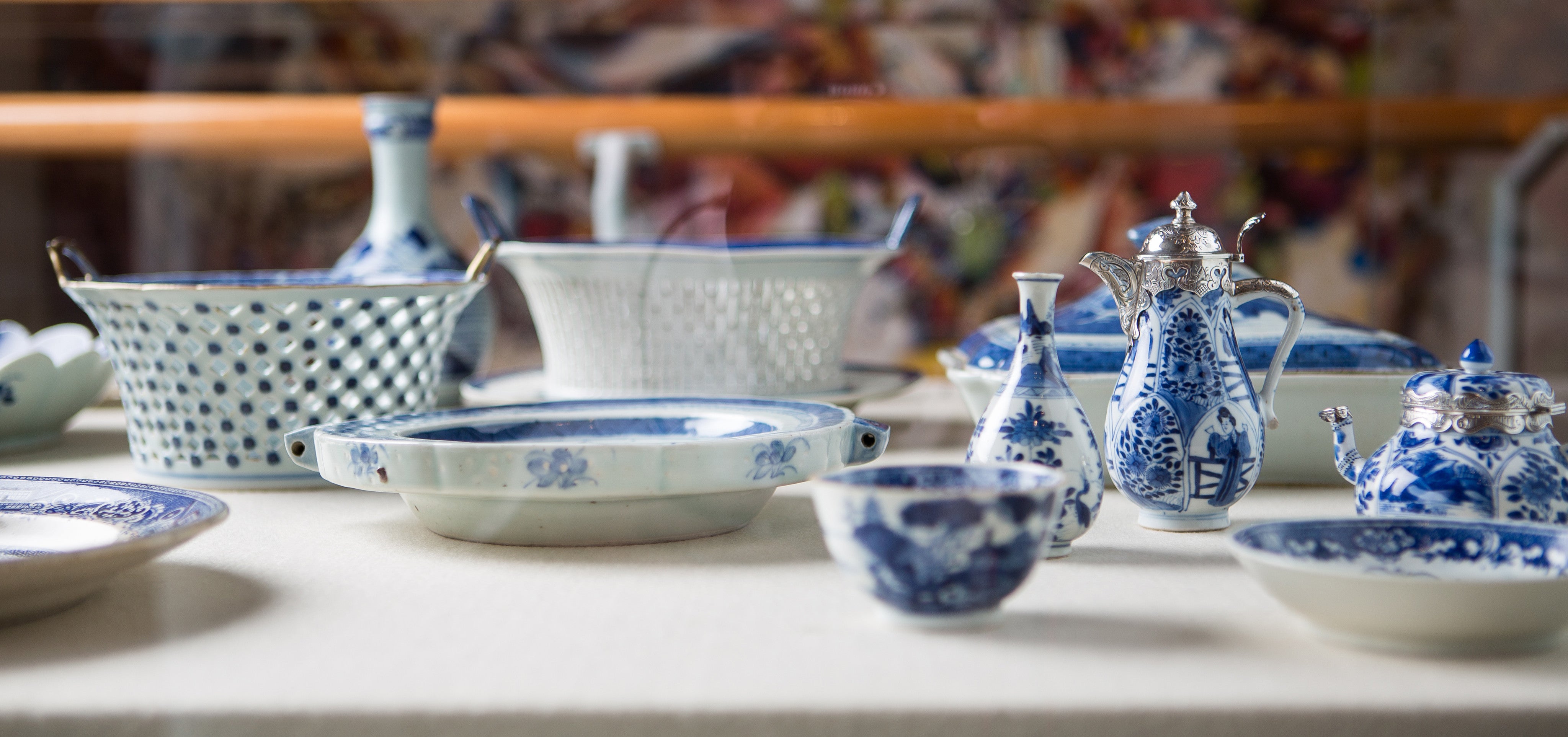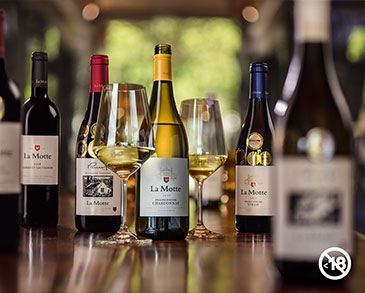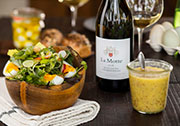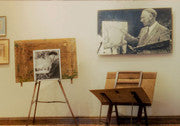
As part of our Art in Clay exhibition called Tables of the Cape – the traditions of blue and white porcelain, last night we had a talk by ceramic artist and lecturer on ceramics, Samantha Read.
She focused on the works on display in the La Motte Museum – 18th and early 19th century blue and white imported porcelain from Iziko’s Social History collection as well as the contemporary work by South African ceramists Anthony Shapiro, Katherine Glenday and Ella-Lou O’Meara who are referencing this tradition in their work.
“The Chinese tradition of Blue and White ceramics is of great historical relevance to South Africa as early Dutch settlers brought Chinese and European blue and white porcelain to the Cape from the 1600’s.
The use of cobalt blue in the decoration of ceramics has played an unequalled role in every great pottery tradition from Europe, the Islamic world and the Far East. Cobalt oxide provides a good blue colour on ceramics across a variety of temperatures from earthenware to stoneware.
It was first found in Samarra in the Islamic world on pots decorated with Kufic script in cobalt blue on soft tin glaze. Samarra was built and occupied by the Caliphs between 836AD and 892AD therefore dated to the 9th century. The early history of Islamic ceramics is very uncertain so it is possible that archaeologists will still discover cobalt blue before this date.
In China it was used as early as the T’ang Dynasty around the 8th century B.C. but its usage disappeared with the fall of the Dynasty and was later reintroduced to China from Persia in the 13th and 14th centuries. The Chinese blue and white surge started in the 14th century and continues to the present day as a stimulus to potters everywhere.
Yuan blue and white is densely decorated and powerfully painted with floral meanders, phoenixes and other creatures. These dishes and rarer vases are often massive and were exported widely to South East Asia, India and the Middle East. The magnificent dishes of the 14th century and classic wares of the 15th century were collected and treasured by the rulers of the Muslim world and a few pieces found their way to Europe before the 16th century through trade with the Arab world.
The Sung Dynasty 960 – 1279 AD is known as the classical age of Chinese arts and ceramics. During this period Chinese potters concentrated less on decoration and more on refining their forms. Many beautiful monochrome glazes were used on simple elegant porcelain forms to produce amongst others Ding, Celadon, Chun, Ju, Kuan and Ch’ing pai wares.
Pots were highly regarded from early times by both religious and secular leaders in China. The Imperial court commissioned work and later established an Imperial pottery factory at Jing dezhen. Pots played an important role in religion and had a huge influence on society. The city of Jingdezhen was appointed as the main centre of porcelain production and is still the largest producer of porcelain in the world today.
The Ming Dynasty 1368 –1644 AD brought about the famous blue and white wares so highly treasured throughout the world. Ming blue and white wares of the 15th century are technically and aesthetically excellent. Later in the Ming Dynasty the quality of the wares declined as more and more wares were exported to Japan and Europe. Enamel colours started to be applied over the underglaze blue painting. The Portuguese, Dutch and English began to trade with China in the 16th and17th century. The fashion of blue and white porcelain then spread throughout Europe, peaking during the 17th century.
The Ching Dynasty 1644 – 1912 AD came to power in the first half of the 18th century with a large market for export and domestic pottery. By this time the Dutch East India Company was trading Chinese goods to most of the Western world. Enamel colours had become very popular by this time with a style known as “Famille” enamel very popular. The term “Famille” means family and refers to the families of certain colours used to decorate the wares. The main colours being Famille Vert – green, Famille Noire – black, Famille Jaune – yellow and Famille Rose – pink. Many lavish dinner services were made in these colours with designs copied from European prints. Towards the end of the Ching Dynasty the standard of the wares declined as there was a tendency towards over decoration.
Japanese porcelain of the Edo period (1600-1868AD) soon rivalled that of the Chinese with large quantities being exported throughout Europe. In the late 17th and early 18th centuries, European royalty and nobility collected Japanese ceramics extensively – Queen Mary II of England and Augustus the Strong Elector of Saxony highly prized Arita, Imari and Kakiemon wares. The 18th century brought a decline in Japanese export wares because it closed itself off to the outside world and its influence
Portuguese and Dutch traders imported blue and white wares in the 16th and 17th centuries and this stimulated the production of blue and white European wares of Delft, Maiolica and Faience. No European potteries could match the porcelains of the Kang Xi period 1662 – 1722.
Chinese porcelains more than any other field of Chinese art reflects the cross cultural fertilization brought about by trade. These porcelains found their place alongside gems and precious metals and appeared in Dutch and Flemish still life paintings.
Tin glaze was produced as early as the 6th century in the Middle East as Islamic potters had no white clay body. Tin glaze was developed to imitate the whiteness of Chinese porcelain. It was a technique soon adopted by all the countries which came into contact with it through trade. It has many names usually classified according to the place of manufacture for example in Spain and Italy tin glazed wares are known as Maiolica, in France and other European countries wares are known as Faience and in Holland and England tin glaze is known as Delft.
The technique of tin glaze came to Holland in 1512 from Italy through a potter by the name of Guido Andries (da Savino)n who set up a Maiolica pottery in Antwerp. He produced ceramics in Italian style and slowly absorbed Dutch motifs in his work. The industry now centered around Delft and became known as Delft.
The founding of the Dutch East India Company (D.E.I.C) in 1609 resulted in large quantities of Ming blue and white wares of the Wan Li reign being imported to Europe. These wares were imitated by the Dutch potters. The importation of tea from China to Europe also sparked off an enormous trade in teapots. After Wan Li’s death in 1619 the fall of the Ming dynasty resulted in a drastic reduction in the amount of imported Chinese pottery. The Dutch potters strove to imitate the blue and white wares and as a result earthenware became thinner, drawing more refined and both the back and front of wares were tin glazed. Lead glaze was sprayed over the decoration to give greater smoothness to the finished wares. This technique was known as Kwaart. Another innovation was the ‘trek’ technique with the introduction of manganese purple to the palette, used to outline the patterns before painting.
During the early 17th Century direct copies of Ming wares were made, decorated with peonies, Buddhist symbols, geese, deer, scrolls, etc. These Blue and white wares dominated for approximately 100 years.
When Ch’ing polychrome enamels became popular, the Delft potters produced polychrome wares. The Japanese Imari style was also copied. All of this with amazing skill as it is almost impossible to distinguish between the earthenware and the porcelain wares. Dutch character wares gradually gained popularity and Chinoiserie elements were combined with indigenous decoration such as European flowers, seascapes and buildings.
The quantity of 17th and 18th century blue and white wares available in the West is still enormous. This is due to the fact that large quantities of pieces were used to fill out the holds of merchant ships of the Dutch East India Company. This was a handy, profitable way of carrying fragile and light spices, tea and textiles from Batavia and Canton.
In 1567 Guido Andries’s son Jasper Andries and a man named Jacob Jansen went to England and set up a Maiolca pottery in London manufacturing wares similar to Dutch wares in design. Potteries were also established outside of London in Bristol and Liverpool both of which are ports which has relevance as it was important for importing as well as exporting.
The contact with other countries had an influence on what was being made. The English style developed based on very English imagery – ships, coats of arms, biblical scenes, floral and fruit designs as well as informal portraits of Kings and Queens.
The effects of the D.E.I.C on South African ceramics is due to the establishment of a refreshment station at the Cape of Good Hope by Jan van Riebeeck in 1652. Ceramic wares came to the Cape on Dutch ships from China, thus starting South Africa’s history of blue and white porcelain and hence the reason many Chinese, Japanese and later European blue and white antique wares are to be found in museum collections in South Africa – such as the pieces from Iziko that is now on display in the La Motte Museum.
Due to politics and pirates, no exports came out of China from 1657 – 1681. During this period Jan van Riebeeck sent samples of clay to Amsterdam for analysis thus starting the process of making earthenware at the Cape.
Today many contemporary artists are influenced by the blue and white tradition as well as influences from Europe, Scandinavia and America – all of which combined in the unique contemporary wares of which exceptional examples are now available for viewing in the La Motte Museum.”











